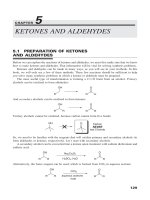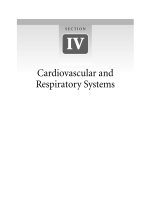Ebook Surgical approaches to the facial skeleton (3/E): Part 2
Bạn đang xem bản rút gọn của tài liệu. Xem và tải ngay bản đầy đủ của tài liệu tại đây (4.27 MB, 185 trang )
SECTION 5
Transfacial Approaches to
the Mandible
260
The mandible can be exposed by surgical approaches using incisions
placed on the skin of the face. The position of the incisions and anatomy
vary depending on the region of the mandible that is approached. Because
there are almost no anatomic hazards in the transfacial exposure of the
mandibular symphysis, this approach is not presented. The focus of this
section is on the submandibular, retromandibular, and rhytidectomy
approaches. All these are used to expose the posterior regions of the
mandible and all must negotiate important anatomic structures.
Approaches to the temporomandibular joint are presented in Section 6.
261
9
Submandibular
Approach
The submandibular approach is one of the most useful approaches to the
mandibular ramus and posterior body region, and is occasionally referred
to as the Risdon approach. This approach may be used for obtaining
access to a myriad of mandibular osteotomies, angle/body fractures, and
even condylar fractures and temporomandibular joint (TMJ) ankylosis.
Descriptions of the approach differ on some points, but in all the incision
is made below the inferior border of the mandible (Video 9.1).
Surgical Anatomy
Marginal Mandibular Branch of the Facial Nerve
After the facial nerve divides into temporofacial and cervicofacial
branches, the marginal mandibular branch originates and extends
anteriorly and inferiorly within the substance of the parotid gland. The
marginal mandibular branch or branches, which supply motor fibers to the
facial muscles in the lower lip and chin, represent the most important
anatomic hazard while performing the submandibular approach to the
mandible. Studies have shown that the nerve passes below the inferior
border of the mandible only in very few individuals (see Fig. 9.1). In the
Dingman and Grabb classic dissection of 100 facial halves, the marginal
mandibular branch was almost 1 cm below the inferior border in 19% of
the specimens (1). Anterior to the point where the nerve crossed the facial
262
artery, all dissections in the above study displayed the nerve above the
inferior border of the mandible.
Ziarah and Atkinson (2) found more individuals in whom the marginal
mandibular branch passed below the inferior border. In 53% of 76 facial
halves, they found the marginal mandibular branch passing below the
inferior border before reaching the facial vessels, and in 6%, the nerve
continued for a further distance of almost 1.5 cm before turning upward
and crossing the mandible. The farthest distance between a marginal
mandibular branch and the inferior border of the mandible was 1.2 cm. In
view of these findings, most surgeons recommend that the incision and
deeper dissection be at least 1.5 cm below the inferior border of the
mandible.
Another important finding of the study by Dingman and Grabb (1) was
that only 21% of the individuals had a single marginal mandibular branch
between the angle of the mandible and the facial vessels (see Fig. 9.2);
67% had two branches (Fig. 9.1), 9% had three branches, and 3% had four.
FIGURE 9.1 Anatomic dissection of the lateral face showing the
relation of the parotid gland, submandibular gland, facial artery
(FA) and vein (FV), and marginal mandibular branches of the facial
263
nerve (VII). Two marginal mandibular branches are present in this
specimen, one below the inferior border of the mandible.
FIGURE 9.2 Anatomic dissection of the lateral face showing the
relation of the submandibular gland, facial artery (FA) and vein
(FV), retromandibular vein (RV), and marginal mandibular branch
of the facial nerve (VII) (parotid gland has been removed). Only one
marginal mandibular branch is present in this specimen and it is
superior to the inferior border of the mandible.
Facial Artery
After it originates from the external carotid artery, the facial artery follows
a cervical course during which it is carried upward medial to the mandible
and in fairly close contact with the pharynx. It runs superiorly, deep to the
posterior belly of the digastric and stylohyoid muscles, and then crosses
above them to descend on the medial surface of the mandible, grooving or
passing through the submandibular salivary gland as it rounds the lower
border of the mandible. It is visible on the external surface of the mandible
264
around the anterior border of the masseter muscle (Figs. 9.1 and 9.2).
Above the inferior border of the mandible, it lies anterior to the facial vein
and is tortuous.
Facial Vein
The facial (anterior facial) vein is the primary venous outlet of the face. It
begins as the angular vein, in the angle between the nose and eye. It
generally courses along with the facial artery above the level of the inferior
mandibular border, but it is posterior to the artery (Figs. 9.1 and 9.2).
Unlike the facial artery, the facial vein runs across the surface of the
submandibular gland to end in the internal jugular vein.
Technique
STEP 1. Preparation and Draping
Pertinent landmarks on the face, useful during dissection, should be left
exposed throughout the procedure. For surgeries involving the
mandibular ramus/angle, the corner of the mouth and lower lip should be
exposed within the surgical field anteriorly and the ear, or at least the ear
lobe, posteriorly. These landmarks help the surgeon to mentally visualize
the course of the facial nerve and to see whether the lip moves if
stimulated.
STEP 2. Marking the Incision and Vasoconstriction
The skin is marked prior to the injection of a vasoconstrictor. The
incision is placed 1.5 to 2 cm inferior to the mandible. Some surgeons
place the incision parallel to the inferior border of the mandible; others
place the incision in or parallel to a neck crease (see Fig. 9.3). Incisions
made parallel to the inferior border of the mandible may be unobtrusive
in some patients; however, extensions of this incision anteriorly may be
noticeable unless hidden in the submandibular shadow. A less
conspicuous scar results when the incision is made in or parallel to a skin
crease. It should be noted that skin creases below the mandible do not
parallel the inferior border of the mandible but run obliquely,
posterosuperiorly to anteroinferiorly. Therefore, the further anterior the
incision in or parallel to a skin crease, the more the distance to dissect to
reach the inferior border of the mandible. Both incisions can be extended
posteriorly to the mastoid region if necessary.
265
Mandibular fractures that shorten the vertical height of the ramus by
their displacement (e.g., condylar fractures in patients without posterior
teeth or those not placed into MMF) will cause the angle of the mandible
to be more superior than it would be following reduction and fixation.
Therefore, the incision should be placed 1.5 to 2 cm inferior to the
anticipated location of the inferior border.
The incision is located along a suitable skin crease in the
anteroposterior position that is needed for mandibular exposure. For a
fracture that extends toward the gonial angle, the incision should begin
behind and above the gonial angle, and extend downward and forward
until it is in front of the gonial angle. For fractures located more anterior
than the gonial angle, the incision does not have to extend behind and/or
above the gonial angle, but may have to extend further anteriorly.
Vasoconstrictors with local anesthesia injected subcutaneously to aid
hemostasis should not be placed deep to the platysma muscle because the
marginal mandibular branch of the facial nerve may be rendered
nonconductive, making electrical testing impossible. Alternatively, a
vasoconstrictor without local anesthesia can be used both superficially
and deep to the platysma muscle to promote hemostasis.
266
FIGURE 9.3 Two locations of submandibular incisions. Incision A
parallels the inferior border of the mandible. Incision B parallels or
is within the resting skin tension lines. Incision B leaves a less
conspicuous scar in most patients.
STEP 3. Skin Incision
267
The initial incision is carried through the skin and subcutaneous tissues to
the level of the platysma muscle (see Fig. 9.4A). The skin is undermined
with scissor dissection in all directions to facilitate closure. The superior
portion of the incision is undermined approximately 1 cm; the inferior
portion is undermined approximately 2 cm or more. The ends of the
incision can be undermined extensively to allow retraction of the skin
anteriorly or posteriorly to increase the extent of mandibular exposure. In
this manner, a shorter skin incision can provide a large extent of
exposure. Hemostasis is then achieved with electrocoagulation of
bleeding subdermal vessels.
STEP 4. Incising the Platysma Muscle
Retraction of the skin edges reveals the underlying platysma muscle, the
fibers of which run superoinferiorly (Fig. 9.4B). Division of the fibers
can be performed sharply, although a more controlled method is to
dissect through the platysma muscle at one end of the skin incision with
the tips of a hemostat or Metzenbaum scissors. After undermining the
platysma muscle over the white superficial layer of deep cervical fascia,
the tips of the instrument are pushed back through the platysma muscle at
the other end of the incision. With the instrument deep to the platysma
muscle, a scalpel is used to incise the muscle from one end of the skin
incision to the other (see Fig. 9.5). The anterior and posterior skin edges
can be retracted sequentially to allow a greater length of platysma muscle
division than the length of the skin incision.
The platysma muscle passively contracts once divided, exposing the
underlying superficial layer of deep cervical fascia (Fig. 9.5C). The
submandibular salivary gland can also be visualized through the fascia,
which helps form its capsule.
268
FIGURE 9.4 A: Incision through skin and subcutaneous tissue to
the level of the platysma muscle. The incision parallels the lines of
minimal tension in the cervical area. The incision does not parallel
the inferior border of the mandible but courses inferiorly as it
extends anteriorly. B: Photograph showing platysma muscle
exposed by undermining of the skin and subcutaneous tissue.
269
FIGURE 9.5 A: Illustration and (B), photograph showing
technique of sharp dissection through the platysma muscle that has
been undermined with a hemostat. C: Photograph showing incised
platysma muscle (PM) retracted and exposure of the superficial
layer of deep cervical fascia overlying the submandibular gland
(SLDCF). The facial vein can be seen at the posterior aspect of the
incision, just deep to the platysma muscle (FV).
STEP 5. Dissection to the Pterygomasseteric
Muscular Sling
Dissection through the superficial layer of deep cervical fascia is the step
that requires the most care because of the anatomic structures with which
it is associated. The facial vein and artery are usually encountered when
approaching the area of the premasseteric notch of the mandible, as well
as the marginal mandibular branch of the facial nerve (see Fig. 9.6). The
facial vessels can be isolated, clamped, divided, and ligated if they are
intruding into the area of interest (see Fig. 9.7). When approaching the
mandible posterior to the premasseteric notch, these vascular structures
are not generally encountered; if they are, they are easily retracted
anteriorly. However, care must be taken because the marginal mandibular
branch is occasionally inferior to the mandible that is posterior to the
270
premasseteric notch.
271
272
FIGURE 9.6 A: Illustration showing anatomic relation of the
facial artery and vein, the marginal mandibular branch of the facial
nerve, and the submandibular (premasseteric) lymph node to the
inferior border of the mandible and masseter muscle. B:
Photograph showing facial vessels (FV) and marginal mandibular
branches of the facial nerve (VII).
273
FIGURE 9.6 (continued)C: Photograph showing relation between
marginal mandibular branch of the facial nerve (VII) and the
submandibular lymph node (LN). D: Photograph showing relation
of the submandibular lymph node (LN), the facial artery (FA),
marginal mandibular branch of VII (VII) and the submandibular
274
gland (SG).
FIGURE 9.7 Photograph showing isolation of the facial artery and
vein which can be ligated and divided.
Dissection through the superficial layer of deep cervical fascia is
accomplished by nicking it with a scalpel and undermining it bluntly with
a hemostat or Metzenbaum scissors. The level of the incision and
undermining of the fascia should be at least 1.5 cm inferior to the
mandible to help protect the marginal mandibular branch of the facial
nerve. Thus, dissection is performed through the fascia at the level of the
initial skin incision, followed by dissection superiorly to the level of the
periosteum of the mandible. The capsule of the submandibular salivary
gland is often entered during this dissection, and the gland is retracted
inferiorly (see Fig. 9.8). A consistent submandibular lymph node (Node
of Stahr) is usually encountered in the area of the premasseteric notch and
can be retracted superiorly or inferiorly. Its presence should alert the
surgeon to the facial artery just anterior to the node, deep to the
superficial layer of deep cervical fascia. The marginal mandibular branch
of the facial nerve may be located close by, within or just deep to the
superficial layer of deep cervical fascia, passing superficial to the facial
275
vein and artery. An electrical nerve stimulator can be used to identify the
nerve so that it can be retracted superiorly. In many instances, however,
this facial nerve branch is located superior to the area of dissection and is
not encountered.
Dissection continues until the only tissue remaining on the inferior
border of the mandible is the periosteum (anterior to the premasseteric
notch) or the pterygomasseteric sling (posterior to the premasseteric
notch).
STEP 6. Division of the Pterygomasseteric Sling and
Submasseteric Dissection
With retraction of the dissected tissues superiorly and placement of a
broad ribbon retractor just below the inferior border of the mandible to
retract the submandibular tissues medially, the inferior border of the
mandible is seen. The pterygomasseteric sling is sharply incised with a
scalpel along the inferior border, which is the most avascular portion of
the sling (see Fig. 9.9). Incisions in the lateral surface of the mandible
into the masseter muscle often produce bothersome hemorrhage.
Increased exposure of the mandible is possible by sequentially retracting
the overlying tissues anteriorly and posteriorly, permitting more exposure
of the inferior border for incision.
276
277
FIGURE 9.8 Coronal illustration showing the path of dissection.
The initial dissection is through the platysma muscle (PM) to the
superficial layer of deep cervical fascia (SLDCF), then through the
area of the submandibular gland (SG) to the periosteum (P) of the
mandible (Mandible), which is incised at the inferior border. ZA,
zygomatic arch; MM, masseter muscle; VII, marginal mandibular
branch of the facial nerve; FA, facial artery.
FIGURE 9.9 A: Illustration showing incision through the
pterygomasseteric sling after retraction of vital structures. The
incision should be at the inferior border of the mandible because it
is the most avascular area in which the masseter and medial
pterygoid muscles join. (continued)
278
FIGURE
9.9
(continued)
B:
Photograph
showing
pterygomasseteric sling exposed (*) and line of incision inferior to
the border of the mandible (dashed line).
The sharp end of a periosteal elevator is drawn along the length of the
periosteal incision to strip the masseter muscle from the lateral ramus.
Care is taken to keep the elevator in intimate contact with the bone, else
shredding of the masseter results, causing bleeding and making retraction
of the shredded tissue difficult. The entire lateral surface of the
mandibular ramus (including the coronoid process) and body can be
exposed to the level of the TMJ capsule (see Fig. 9.10), taking care to
avoid perforating into the oral cavity along the retromolar area, if this is
not desired. Once the buccinator muscle has been stripped from the
retromolar area the only tissue separating the oral cavity from the
dissection area is the oral mucosa. Retraction of the masseter muscle is
facilitated by inserting a suitable retractor into the sigmoid notch
(Channel retractor, Sigmoid notch retractor) (see Fig. 9.11).
279
FIGURE 9.10 Illustration (A) demonstrating the extent of
exposure obtained with the submandibular approach. The channel
retractor is placed into the sigmoid notch, elevating the masseter,
parotid, and superficial tissues. Exposure more anteriorly is
accomplished by retraction in that direction.
FIGURE 9.10 (continued) B: Photograph showing exposure in the
280
area of the mandibular angle and body. C: Photograph showing
exposure of the ramus and subcondylar regions (fractured). D:
Photograph showing exposure of the mandibular body (fractured)
and symphysis. The mental neurovascular bundle is clearly visible
(M).
More anterior in the mandibular body, care is needed to avoid
damage to the mental neurovascular bundle (Fig. 9.10D), which exits the
mental foramen, close to the apices of the bicuspid teeth.
FIGURE 9.11 Sigmoid notch retractor. The curved flange inserts
into the sigmoid notch, retracting the masseter muscle.
281
FIGURE 9.12 Closure of the pterygomasseteric sling (inset) and
platysma. The pterygomasseteric sling is closed with resorbable
interrupted suture. The platysma can be closed with a running
resorbable suture, taking care to avoid damaging the underlying
blood vessels and the seventh nerve.
STEP 7. Closure
The masseter and medial pterygoid muscles are sutured together with
interrupted resorbable sutures (see Fig. 9.12). It is often difficult to pass
the suture needle through the medial pterygoid muscle which is thin at the
inferior border of the mandible. To facilitate closure, it is possible to strip
the edge of the muscle for easier passage of the needle.
282
The superficial layer of the deep cervical fascia does not require
definitive suturing. The platysma muscle may be closed with a running
resorbable suture (Fig. 9.12). Subcutaneous resorbable sutures followed
by skin sutures are placed.
Extended Submandibular Approaches to the
Inferior Border of the Mandible
Several choices are available if more exposure of the mandible becomes
necessary. For increased ipsilateral exposure, the submandibular incision
can be extended posteriorly toward the mastoid region, and anteriorly in an
arcing manner toward the submental region (see Fig. 9.13). Once the
incision leaves the direction of the resting skin tension lines however, the
resultant scar will be more obvious.
To eliminate some of the undesirable scarring that may accompany the
change in direction of the incision toward the submental area, one can step
the anterior portion of the incision (see Fig. 9.14) (3).
Surgical splitting of the lower lip is another maneuver used
occasionally in combination with incisions in the submandibular area to
increase the exposure of one side of the mandible. It is possible to divide
the lower lip in several ways. Each method uses the principle of breaking
up the incision line to minimize scar contracture during healing (see Figs.
9.14 and 9.15).
283
FIGURE 9.13 Extension of the submandibular incision posteriorly
toward the mastoid region and anteriorly toward the submental
region. Note that the incision leaves the resting skin tension lines
anteriorly.
284









